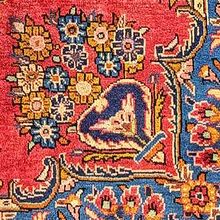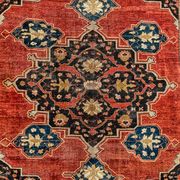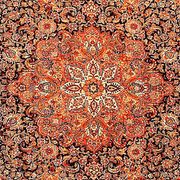Golpayegan Rug
| Golpayegan Rug | |
|---|---|
 Design of Golpayegan Rug (Rugman) | |
| General information | |
| Name | Golpayegan Rug |
| Original name | قالی گلپایگان |
| Alternative name(s) | Golpayegan Carpet |
| Origin | |
| Category | City |
| Technical information | |
| Common designs | Lachak Toranj, Afshan |
| Common colors | Red, Blue, Green, Beige, Ivory |
| Dyeing method | Natural, Synthetic |
| Pile material | Wool |
| Foundation material | Cotton |
| Knot type | Asymmetrical (Persian) |
Golpayegan rugs are hand woven in the Isfahan Province in central Iran. Due in large part to its proximity to Viss, they tend to produce similar types of area rugs. However, in comparison to others produced in the surrounding area, Golpayegan rugs are of a much finer quality. They certainly differentiate themselves with more intense colors and contrasts in addition to very attractive geometric shapes. Golpayegan rugs are woven using the asymmetrical knot with an average KPSI (knots per square inch) of 82.
History
Golpayegan is a town located in the Isfahan Province in central Iran. It is situated near three provinces, Arak (Markazi), Isfahan, and Qum, all of which are famous for carpet production. Carpets made in Golpayegan are known in the market from the twentieth century.[1]
Materials
Foundation and Pile
in the late twentieth century Golpayegan weavers began to weave a finer quality, including rugs with a silk foundation and a silk pile.[2] The carpets of the region tend to be like coarse Arak rugs but tend to be thick well made rugs with good wool.
Techniques and structures
Color and dyeing
The colors Golpayegan rugs are predominantly in shades of red, navy blue, baby blue, olive green, beige, and ivory. The wool and cotton in Golpayegan rugs are dyed with a vegetable extract.
Motifs and Designs
The Golpayegan carpets imitated or were commissioned to use Qum and Farahan regional designs; Golpayegan weavings were marketed as Qum or Farahan carpets. The carpets were considered lower in grade quality than original Qum or Farahan carpets.[3]
Weaving techniques
Golpayegan rugs weavings were similar to the finer-quality Qum carpets.[4]
See also
| Search for Golpayegan Rug on Wikipedia. |
References
Bibliography
- Abraham Levi Moheban, (2015), The Encyclopedia of Antique Carpets: Twenty-Five Centuries of Weaving, NewYork: Princeton Architectural Press.



